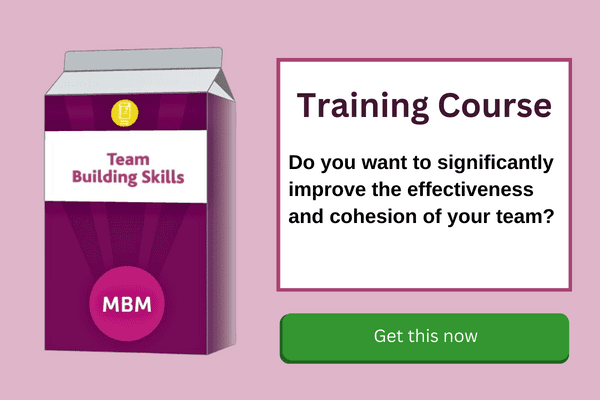Virtual Team Games, Remote Team Icebreakers, and Zoom Games
Working from home can mean that virtual teams and remote teams become stifled. All work and no play. These virtual team ice breaker ideas, and zoom games will help your team to feel more like a team. A little will ensure that the phrase, ‘All work and no play makes Jack a dull boy’, stays firmly in the nursery books of yesteryear.
We have selected the very best virtual team ice breaker ideas, remote team building activities, and virtual team bonding activities from our experience of 18 years building teams, from those shared by our trainers. And we have scoured the web to ensure that we had not missed any corkers that will really help you to build a great team.

#1 Name That Song
- Overview:
- One person is the music master. They play songs and ask others to guess the song. The person with the most points wins.
- Instructions:
- Use an app like Spotify on your phone. Choose songs that you think your audience will know. For example, if they are younger than 20, the current charts, or older than 40, the 80’s playlist. Explain to your group that they get 1 point for guessing correctly and also 1 point deducted if they guess incorrectly (This stops people shouting out many times). Keep a scoresheet showing names and points.
- Number of people: Up to 10.
- Potential pitfall: You don’t hear who shouts out first.
- Duration: From 5-minutes to 10-minutes. After that, it can become repetitive.
- Difficulty: (1 is easy and 5 is hard): 2.
- Advanced: Have rounds. For example, an 80’s round, or a TV themes round.
#2 Two Truths, One Lie…
- Overview:
- A quick and easy way to get participants engaged in the meeting, and in each other. Beware, however! The best liars will be revealed with this game…
- Instructions:
- As the call host, explain to your participants that they have 3-4 minutes to write down 3 things about themselves. 2 of these things must be true, and 1 must be false. Move through the group, asking each member to read out their statements and allowing remaining members the chance to guess which is which. Allow each member to reveal the truth after their go, and watch as call participants learn interesting facts, and personality quirks about each other.
- Number of people: Up to 5 players.
- Potential pitfall: Difficulty with thinking of all 3 statements.
- Duration: About 20 minutes, with 5 players.
- Difficulty: (1 is easy and 5 is hard): 2.
- Advanced: Crown a winner from either the person who guessed the most correctly, or the person who fooled everyone!

#3 Rose, Rose, Thorn, Bud
- Overview:
- Get participants engaged and sharing by posing a discussion about the current ups and downs they’re facing.
- Instructions:
- Each participant must write down 4 statements: Two ‘roses’, things that are going well for them, a ‘thorn’, something that isn’t going so well, and a ‘bud’, something positive that’s on the horizon. Allow 5 or 6 minutes for this. Once completed, each group member must share their Roses, Thorns, and Buds with the group. As the call host, encourage engagement by asking further into member’s statements and sparking conversation from particularly interesting ones.
- Number of people: up to 5 players.
- Potential pitfall: Difficulty coming up with all 4 statements.
- Duration: About 20 minutes, with 5 players.
- Difficulty: (1 is easy and 5 is hard): 2.
- Advanced: Multiple of each item, as many as seen fit. Discuss statements in-depth to increase engagement.

Sticky Learning ® is 7 times more effective than 1-day training courses. Plus, you will get a Chain of Evidence proving your Return on Investment. Discover soft skills training that changes behaviours long term.

#4 About Me…
- Overview:
- Each person submits a fact, remaining participants match fact to face. The member with the most correct guesses wins.
- Instructions:
- The call’s host must be the ‘games-master’ here. Each remaining member must email, WhatsApp, or Skype message the host with a single unique or interesting fact about themselves. ‘I completed Mount Everest base camp last year!’, would be a great example. Once the host has compiled all unique facts, they must read them aloud one-by-one. The remaining members must guess whose fact is whose. Each person who guesses the correct author of the fact, wins a point. At the end, most points wins! Make sure the author takes a guess too, otherwise everyone will know the answer!
- Number of people: Up to 10 players, plus a games-master.
- Potential pitfall: Email or WhatsApp errors.
- Duration: About 20 minutes, with 10 players.
- Difficulty: (1 is easy and 5 is hard): 1.
- Advanced: Allow players to try and match fact to face, and reveal the scores, along with the winner at the end of the game.

#5 One Word, and I’m in!
- Overview:
- A quick, easy and fun icebreaker. Each person fills the sentence gap to explain how they’re feeling. This one can get really creative!
- Instructions:
- The sentence is ‘I’m ___ and I’m in!’ To get some energy flowing through your zoom call, have each participant fill the sentence gap and repeat the sentence aloud to the group. To start off, you could say something like “I’m caffeinated, and I’m in!”. Pass the buck to participant number 2 and continue as follows. With a large group of people, sentences can get lengthy!
- Here are some examples:
- “I’m a-little-tired-but-ready and I’m in!”
- “I am excited-that-it’s-Friday and I’m in!”
- “I’m raring-to-go and I’m in!”
- “I am not-so-excited-that-it’s-Monday-but-I’m-ready and I’m in!”
- Number of people: Up to 20 players.
- Potentiall pitfall: Putting participants on-the-spot.
- Duration: About 10 minutes, with 20 players.
- Difficulty: (1 is easy and 5 is hard): 0.
- Advanced: Play quick fire rounds, choosing members in random order and allowing 10 seconds for a sentence, no duplicates!

#6 Desktop Snap!
Halfway through our virtual team ice breaker ideas – here’s number 6!
- Overview:
- Match desk to person in this fun ice-breaking game that gives a little insight into your teammates’ work-life.
- Instructions:
- Instruct each member of the call to snap a quick mobile phone picture of their desk as it is, without moving anything. Explain that they then need to send the photo to the host (to you) on any platform. As long as you can access it on desktop, you can show it live. Once you’ve received all photos, share your screen with the group and have them guess whose desk is whose. The accuracy of guesses will be surprising!
Encourage members to include the half-drunk cup of coffee or the slightly embarrassing mouse-mat in their photo, a little humility will propel the engagement from this activity. Side note: setting up a quick google drive folder for everyone to send photos to may just make life a little easier.
- Number of people: Up to 8.
- Potential pitfall: Tech problems, sending/recieving etc.
- Duration: About 12-15 minutes, with 8 players.
- Difficulty: (1 is easy and 5 is hard): 3.
- Advanced: Throw a snap of your own desk in the mix but don’t mention it, see if anyone can catch on!

#7 Pancakes vs. Waffles
- Overview:
- Explore opinions and preferences by posing ‘would you prefer…?’ questions that build as conversation continues.
-
- Instructions: As the call host, start off by posing the question: ‘would you prefer pancakes, or waffles?’ and explaining that whichever is chosen moves on, and the remaining option is hypothetically eradicated from the planet – tough decisions, majority rules. Once waffles (the obvious choice) has been chosen to move on, the host must decide the next opponent. Now, it becomes; ‘Waffles or wine?’, a slightly harder question for some…
- As the host, it may be a good idea to have a small list of potential opponents ready to go, to increase efficiency.
- Number of people: Up to 10.
- Potential pitfall: Although majority rules in this game, expect some conflict of interests.
- Duration: About 10 minutes. (About 1 minute to discuss andd concluded each debate, 10 opponents is usually sufficient).
- Difficulty: (1 is easy and 5 is hard): 1.
- Advanced: Scrap majority rules and say the vote must be unanymous. This will urge the majority to convince the minority before they can move on – great for team building and communication skills.

#8 Show and Tell… Within an Arm’s Reach!
- Overview:
- Provide a snippet of your life outside of work by describing something in your workspace that’s meaningful to you. Each member must do this, and listen intently to the explanations of others.
- Instructions:
- As the call host, have each participant choose something that is within an arm’s reach from where they are. This item must be significant or meaningful to that person. Once they’ve chosen an object, they must explain why it is significant for them. This may be a family photo on the desk or, a poster on the wall, a book on the shelf, or a pen in the pot. One-by-one, each participant will explain their item and learn about others in the process.
- Number of people: Up to 10 players.
- Potential pitfall: Members with nothing significant in an arm’s reach.
- Duration: 10 minutes (10 players x 1 minute per player). This can be controlled as desired.
- Difficulty: (1 is easy and 5 is hard): 3.
- Advanced: Set time limits for explaining, set word limits for explaining (“In five words, why is that item significant?”), or move around the team multiple times.

#9 Split the Zoom
- Overview:
- Watch as 50/50 preference options create a split in the team.
- Instructions:
- As the call host, you will be presenting scenarios. Have some ready to go to make things move quicker (a quick search for ‘split the room questions’ will eliminate preparation time). Present multiple ‘would you rather?’ type questions and explain to the team that they must raise left hands for option 1, and right hands for option 2. If 10 players vote 4 left and 6 right, the room has a 60:40 split. Watch as team members question each other’s answers from each side of the split.
- Some examples to get you started:
- “You’ve just woken up and must begin the day. To get ready for work, do you brush your teeth before eating breakfast, or eat breakfast first?”
- “You’re undergoing a job interview for a very prestigious role at Google HQ, their make or break question is; “how do you pronounce ‘GIF’?” You’ve the choice to say G-I-F or J-I-F. If you are wrong, you lose the job, if you’re right, you’re guaranteed a post. What do you say?”
- An easy one: “Marmite..?”.
- Number of people: Up to 10.
- Potential pitfall: Conflict or interest with scenarios that pose moral questioning. (Keep questions light-hearted).
- Duration: About 12-15 minutes. Allow 2-3 minutes per scenario, 4-6 scenarios is usually good to get engagement going.
- Difficulty: (1 is easy and 5 is hard): 2.
- Advanced: Have members guess the ratio split of the room before the room splits, closest person wins each round.

#10 The Longest Word
- Overview:
- Find a very long world online, and have call participants attempt to spell it. No use of the internet permitted!
- Instructions:
- As the call host, find a word on the internet that is long, complicated, confusing, or all of the above. “Consanguineous” and “Trichotillomania” are good examples. Throw your chosen word into google translate and hit the speaker icon, it’ll show you how to pronounce it. Speak this pronunciation aloud to the group and explain that they each should grab a pen and pad and attempt to spell the word. Allow 2-3 minutes for this. Once everyone has their spellings, ask each person to read their spelling aloud – the team member with the fewest wrong letters, or the most correct letters, wins.
- Number of people: Up to 10 players.
- Potential pitfall: Sneaky Google users.
- Duration: About 10-12 minutes, with 10 players.
- Difficulty: (1 is easy and 5 is hard): 0.
- Advanced: Give players 30, 20 or even 10 seconds to spell the word or remove the option to write it down, figure it out mentally

#11 Riddle Me This…
- Overview:
- Get creative juices flowing by presenting and solving riddles within the group.
- Instructions:
- To begin the game, allow 2-3 minutes for each player to think of, or research a tough riddle. Once everyone has a riddle, pick a player to go first. They must read their riddle aloud to the group. Once read, each player must respond with what they think the answer is. Allow a little thinking time for this. Once all players have answered (you can’t pass, each player must have an answer to every riddle) the riddler can reveal the answer!
- Number of people: Up to 8.
- Potential pitfall: Duplicate riddles.
- Duration: About 10 minutes, with 8 players.
- Difficulty: (1 is easy and 5 is hard): 1.
- Advanced: Sudden death – if you get the riddle wrong, you’re out! Last man standing wins.

#12 The 50 States Challenge
- Overview:
- Name as many states of the U.S.A. as possible in 7 minutes!
- Instructions:
- As the group host, find a list of all 50 states online. Explain to everyone present that they’ll need a pen and paper for this excercise. Explain that they will have 7 minutes to write down as many state names as possible. Each player gets a point per correct state, and a point deducted to incorrect state names. The player with the most points, wins!
- Number of people: Up to 6.
- Potential pitfall: Connection issues may interrupt timer consistency.
- Duration: About 15 minutes, with 6 players.
- Difficulty: (1 is easy and 5 is hard): 2.
- Advanced: Cut the time, 5 minutes instead!

#13 A Tree, or David Beckham?
- Overview:
- Answer questions about an object until the team guess it right!
- Instructions:
- Pick a participant to be the host. This player must think of an object. The remaining players must take it in turns to ask questions like ‘Is it closer to a tree, or David Beckham?’ This must be the first question. The host must make a judgement call based on their chosen object. The ‘closer to’ format must be the basis of all questions. If the object isn’t guessed in 20 questions, the host wins! If it’s guessed correctly, the estimator wins!
- Number of people: Up to 11.
- Potential pitfall: Very obscure objects.
- Duration: About 10 minutes per object, with 11 players.
- Difficulty: (1 is easy and 5 is hard): 3.
- Advanced: Introduce concepts and ideas as well as objects for the host.

#14 Speedy Typist Competition
- Overview:
- Players must type a sentence or paragraph as fast as they can and submit before everyone else!
- Instructions:
- As the host, prepare a series of sentences or paragraphs before the game starts. Instruct everyone to open the chat box in your virtual call. Explain that you will share the paragraph with them, and that it’s a race to type it out and submit it to the chat box the quickest. Share your screen with the first sentence or paragraph (to avoid cut and paste…) and call 3,2,1… GO! Watch as each player scrambles to type the words as quickly as possible. As this is quick, it can be repeated a few times. Whoever submits the full correct sentence first wins, whoever wins the most games… wins the competition!
- Number of people: Up to 10.
- Potential pitfall: Tech issues – chats not sending etc.
- Duration: About 10 minutes, if 5 games are played.
- Difficulty: (1 is easy and 5 is hard): 1.
- Advanced: Prepare complicated or commonly misspelled words for your challenges.

#15 Is the Price Right?
And we’re onto our last of the virtual team icebreaker ideas!
- Overview:
- Guess the price of objects around the office!
- Instructions:
- As the host, hold up and briefly explain a series of objects around your workspace. Ask participants to guess the price of the object one-by-one. Whoever guesses within 20%, or within 50p (set your desired margin) wins a point! Repeat until some points have been racked up, and crown a winner.
- Number of people: Up to 8.
- Potential pitfall: The internet may present a product at a different price, watch out for those who will look this up.
- Duration: About 10 minutes, with 8 players and 6-8 objects.
- Difficulty: (1 is easy and 5 is hard): 3.
- Advanced: Cut the margin, to within 5% or 10p etc.

Action: For even more useful content on team building, check out our ultimate guide on Team Building Skills.




